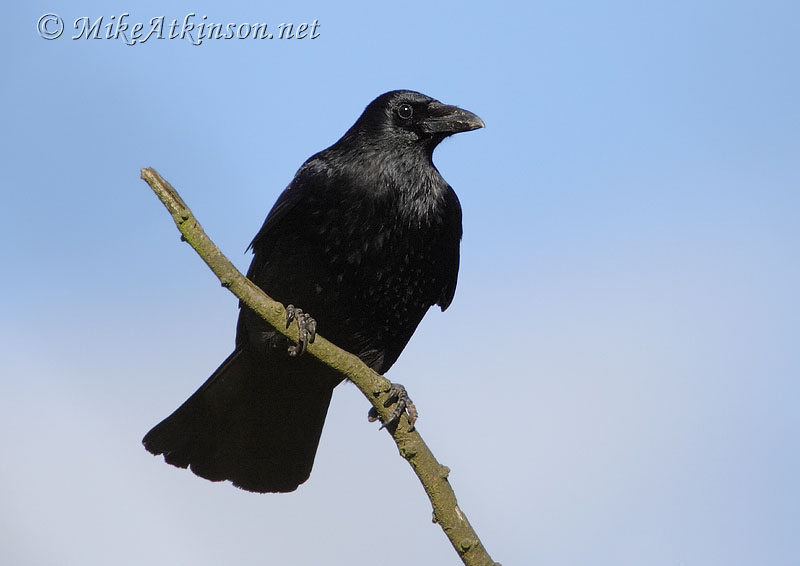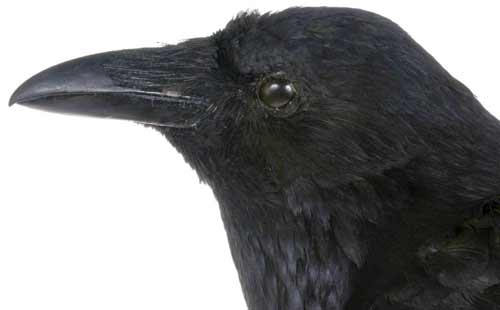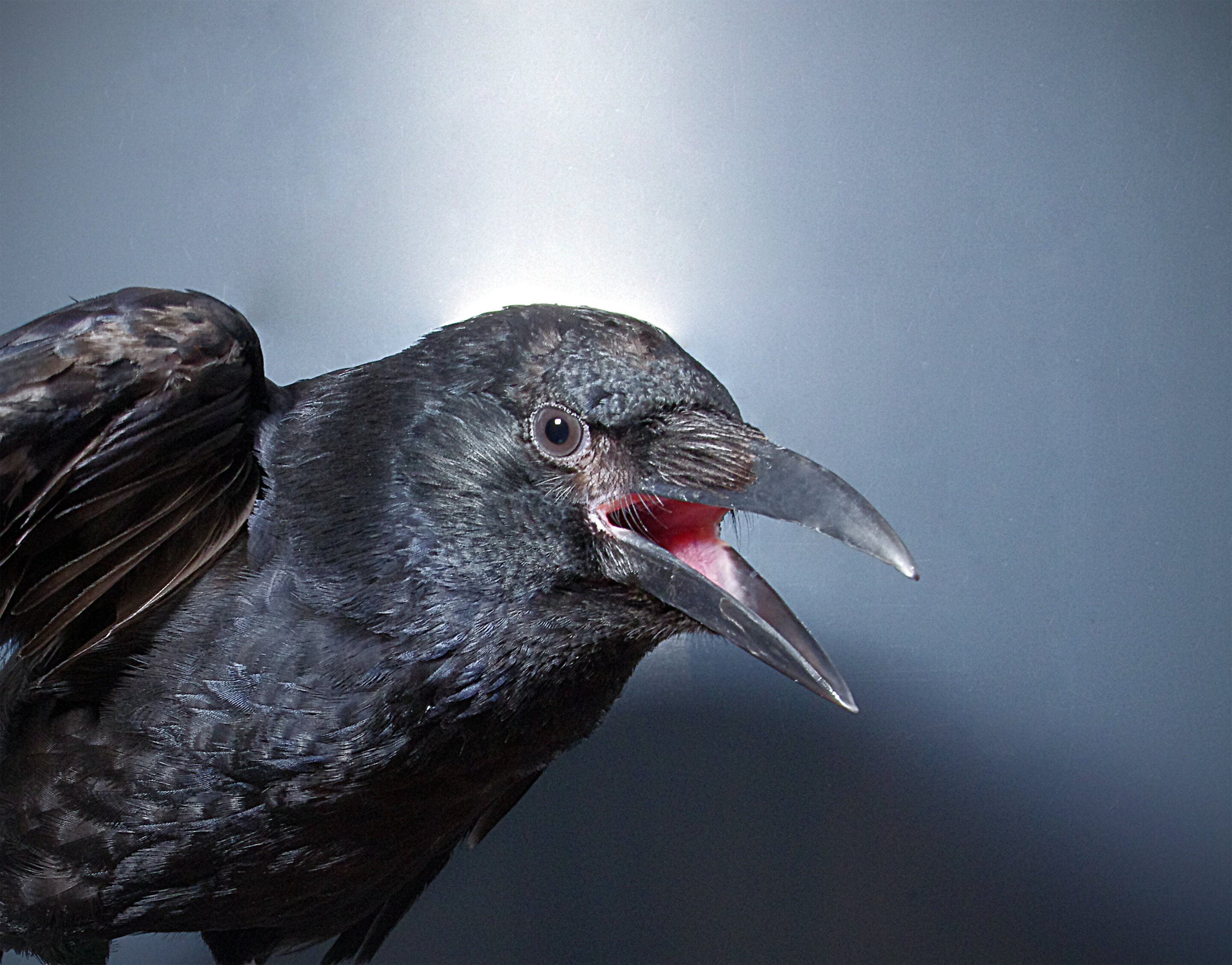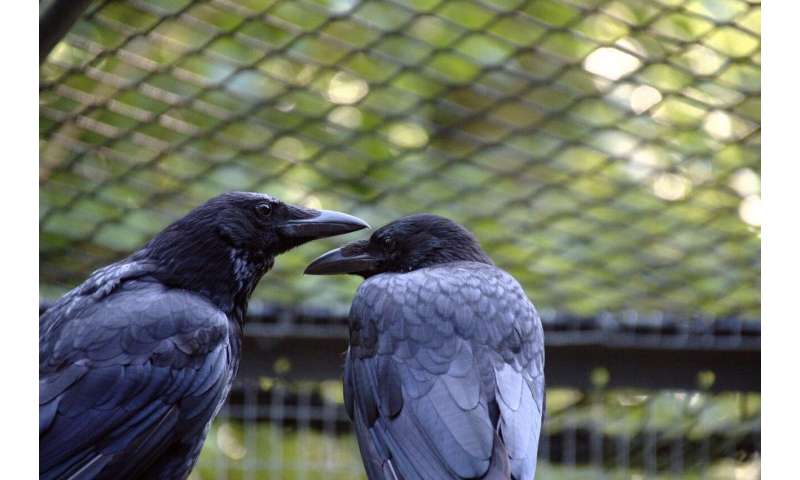Post by Eaglehawk on Aug 28, 2019 7:28:29 GMT
Carrion Crow - Corvus corone

Scientific Classification
Kingdom: Animalia
Phylum: Chordata
Class: Aves
Order: Passeriformes
Family: Corvidae
Genus: Corvus
Species: Corvus corone
The Carrion Crow (Corvus corone) is a member of the passerine order of birds and the crow family which is native to western Europe and eastern Asia.
Taxonomy
The Carrion Crow was one of the many species originally described by Linnaeus in his 18th century work Systema Naturae and it still bears its original name of Corvus corone. The binomial name is derived from the Latin Corvus, "Raven", and Greek corone/κορωνη, "crow". As well as the subspecies of the Hooded Crow being split off as a separate species, there is some discussion whether the Eastern Carrion Crow (C. c. orientalis) is distinct enough to warrant specific status; the two taxa are well separated, and it has been proposed they could have evolved independently in the wetter, maritime regions at the opposite ends of the Eurasian landmass.

Description
The plumage of Carrion Crow is black with a green or purple sheen, much greener than the gloss of the Rook. The bill, legs and feet are also black. It can be distinguished from the Common Raven by its size (48–52 cm or 18 to 21 inches in length) and from the Hooded Crow by its black plumage, but there is frequent confusion between it and the Rook. The beak of the Crow is stouter and in consequence looks shorter, and whereas in the adult Rook the nostrils are bare, those of the Crow are covered at all ages with bristle-like feathers.

Destribution
This species breeds in western and central Europe, with an allied form or race C. c. orientalis (50–56 cm or 19 to 22 inches in length) occurring in eastern Asia. The separation of these two populations is now believed to have taken place during the last ice age, with the closely allied Hooded Crow (now given species status) filling the gap between. Fertile hybrids occur along the boundary between these two forms indicating their close genetic relationship. This is an example of the parapatric speciation model described by Ernst Mayr. The range of this hybrid of these two species appears to be moving to the northwest.

Behavior
The Rook is generally gregarious and the Crow solitary, but Rooks occasionally nest in isolated trees, and Crows may feed with Rooks; moreover, Crows are often sociable in winter roosts. The most distinctive feature is the voice. The rook has a high-pitched kaaa, but the Crow's guttural, slightly vibrant, deeper croaked kraa is distinct from any note of the rook. The Carrion Crow is noisy, perching on the top of a tree and calling three or four times in quick succession, with a slight pause between each series of croaks. The wing-beats are slower, more deliberate than those of the Rook. Like all Corvids, Carrion Crows are highly intelligent, and are among the most intelligent of all animals.
Though an eater of carrion of all kinds, the Carrion Crow will eat insects, worms, grain, small mammals, and scraps and will also steal eggs. Crows are scavengers by nature, which is why they tend to frequent sites inhabited by humans in order to feed on their household waste. Crows will also harass birds of prey or even foxes for their kills. Crows actively hunt and occasionally co-operate with other crows to make kills.
Crows have become highly skilled at adapting to urban environments. In a Japanese city, carrion crows have discovered how to eat nuts that they usually find too hard to tackle. One method is to drop the nuts from height on to a hard road in the hope of cracking it. Some nuts are particularly tough, so the crows drop the nuts among the traffic. That leaves the problem of eating the bits without getting run over, so some birds wait by pedestrian crossings and collect the cracked nuts when the lights turn red.
The bulky stick nest is usually placed in a tall tree, but cliff ledges, old buildings and pylons may be used as well. Nests are also occasionally placed on or near the ground. The nest resembles that of the Common Raven, but is less bulky. The 3 to 4 brown-speckled blue or greenish eggs are incubated for 18–20 days by the female alone, who is fed by the male. The young fledge after 29–30 days. It is not uncommon for an offspring from the previous years to stay around and help rear the new hatchlings. Instead of seeking out a mate, it looks for food and assists the parents in feeding the young.

Crows consciously control their calls
by Public Library of Science

Carrion Crow vocalizing. Credit: Tobias Machts
Crows can voluntarily control the release and onset of their calls, suggesting that songbird vocalizations are under cognitive control, according to a study published August 27 in the open-access journal PLOS Biology by Katharina Brecht of the University of Tübingen, and colleagues.
Songbirds are renowned for their acoustically elaborate songs; these show a degree of flexibility, potentially indicating that they are under conscious control. However, the observed variability in vocalizations might simply be driven by involuntary mechanisms, and need not be based on cognitive control. In the new study, Brecht and colleagues directly tested the idea that songbirds deliberately control their calls, in the sense that they can be emitted or inhibited at will, as opposed to being knee-jerk responses to food, mates, or predators.
The findings show that trained carrion crows (Corvus corone), songbirds of the corvid family, can exert control over their calls in a goal-directed manner. In a detection task, three male carrion crows rapidly learned to emit calls in response to a visual cue (colored squares) with no inherent meaning ("go-trials"), and to withhold calls in response to another cue. Two of these crows were then trained on a task with the cue colors reversed, in addition to being rewarded for withholding vocalizations to yet another cue ("nogo-trials").
Vocalizations in response to the detection of the go-cue were precise timed and highly reliable in all three crows. The crows also quickly learned to withhold calls in nogo-trials, showing that vocalizations weren't produced by an anticipation of a food reward in correct trials. According to the authors, further work is needed to evaluate the neurobiological basis of such cognitive vocal control in birds.
"Our study shows that crows can be thaught to control their vocalizations, just like primates can, and that their vocalizations are not just a reflexive response. This finding not only demonstrates once again the cognitive sophistication of the birds of the crow family. It also advances our understanding of the evolution of vocal control."
phys.org/news/2019-08-crows-consciously.html
Journal Reference:
Brecht KF, Hage SR, Gavrilov N, Nieder A (2019) Volitional control of vocalizations in corvid songbirds. PLoS Biol 17(8): e3000375. doi.org/10.1371/journal.pbio.3000375
Abstract
Songbirds are renowned for their acoustically elaborate songs. However, it is unclear whether songbirds can cognitively control their vocal output. Here, we show that crows, songbirds of the corvid family, can be trained to exert control over their vocalizations. In a detection task, three male carrion crows rapidly learned to emit vocalizations in response to a visual cue with no inherent meaning (go trials) and to withhold vocalizations in response to another cue (catch trials). Two of these crows were then trained on a go/nogo task, with the cue colors reversed, in addition to being rewarded for withholding vocalizations to yet another cue (nogo trials). Vocalizations in response to the detection of the go cue were temporally precise and highly reliable in all three crows. Crows also quickly learned to withhold vocal output in nogo trials, showing that vocalizations were not produced by an anticipation of a food reward in correct trials. The results demonstrate that corvids can volitionally control the release and onset of their vocalizations, suggesting that songbird vocalizations are under cognitive control and can be decoupled from affective states.
journals.plos.org/plosbiology/article?id=10.1371/journal.pbio.3000375

Scientific Classification
Kingdom: Animalia
Phylum: Chordata
Class: Aves
Order: Passeriformes
Family: Corvidae
Genus: Corvus
Species: Corvus corone
The Carrion Crow (Corvus corone) is a member of the passerine order of birds and the crow family which is native to western Europe and eastern Asia.
Taxonomy
The Carrion Crow was one of the many species originally described by Linnaeus in his 18th century work Systema Naturae and it still bears its original name of Corvus corone. The binomial name is derived from the Latin Corvus, "Raven", and Greek corone/κορωνη, "crow". As well as the subspecies of the Hooded Crow being split off as a separate species, there is some discussion whether the Eastern Carrion Crow (C. c. orientalis) is distinct enough to warrant specific status; the two taxa are well separated, and it has been proposed they could have evolved independently in the wetter, maritime regions at the opposite ends of the Eurasian landmass.

Description
The plumage of Carrion Crow is black with a green or purple sheen, much greener than the gloss of the Rook. The bill, legs and feet are also black. It can be distinguished from the Common Raven by its size (48–52 cm or 18 to 21 inches in length) and from the Hooded Crow by its black plumage, but there is frequent confusion between it and the Rook. The beak of the Crow is stouter and in consequence looks shorter, and whereas in the adult Rook the nostrils are bare, those of the Crow are covered at all ages with bristle-like feathers.

Destribution
This species breeds in western and central Europe, with an allied form or race C. c. orientalis (50–56 cm or 19 to 22 inches in length) occurring in eastern Asia. The separation of these two populations is now believed to have taken place during the last ice age, with the closely allied Hooded Crow (now given species status) filling the gap between. Fertile hybrids occur along the boundary between these two forms indicating their close genetic relationship. This is an example of the parapatric speciation model described by Ernst Mayr. The range of this hybrid of these two species appears to be moving to the northwest.

Behavior
The Rook is generally gregarious and the Crow solitary, but Rooks occasionally nest in isolated trees, and Crows may feed with Rooks; moreover, Crows are often sociable in winter roosts. The most distinctive feature is the voice. The rook has a high-pitched kaaa, but the Crow's guttural, slightly vibrant, deeper croaked kraa is distinct from any note of the rook. The Carrion Crow is noisy, perching on the top of a tree and calling three or four times in quick succession, with a slight pause between each series of croaks. The wing-beats are slower, more deliberate than those of the Rook. Like all Corvids, Carrion Crows are highly intelligent, and are among the most intelligent of all animals.
Though an eater of carrion of all kinds, the Carrion Crow will eat insects, worms, grain, small mammals, and scraps and will also steal eggs. Crows are scavengers by nature, which is why they tend to frequent sites inhabited by humans in order to feed on their household waste. Crows will also harass birds of prey or even foxes for their kills. Crows actively hunt and occasionally co-operate with other crows to make kills.
Crows have become highly skilled at adapting to urban environments. In a Japanese city, carrion crows have discovered how to eat nuts that they usually find too hard to tackle. One method is to drop the nuts from height on to a hard road in the hope of cracking it. Some nuts are particularly tough, so the crows drop the nuts among the traffic. That leaves the problem of eating the bits without getting run over, so some birds wait by pedestrian crossings and collect the cracked nuts when the lights turn red.
The bulky stick nest is usually placed in a tall tree, but cliff ledges, old buildings and pylons may be used as well. Nests are also occasionally placed on or near the ground. The nest resembles that of the Common Raven, but is less bulky. The 3 to 4 brown-speckled blue or greenish eggs are incubated for 18–20 days by the female alone, who is fed by the male. The young fledge after 29–30 days. It is not uncommon for an offspring from the previous years to stay around and help rear the new hatchlings. Instead of seeking out a mate, it looks for food and assists the parents in feeding the young.

Crows consciously control their calls
by Public Library of Science

Carrion Crow vocalizing. Credit: Tobias Machts
Crows can voluntarily control the release and onset of their calls, suggesting that songbird vocalizations are under cognitive control, according to a study published August 27 in the open-access journal PLOS Biology by Katharina Brecht of the University of Tübingen, and colleagues.
Songbirds are renowned for their acoustically elaborate songs; these show a degree of flexibility, potentially indicating that they are under conscious control. However, the observed variability in vocalizations might simply be driven by involuntary mechanisms, and need not be based on cognitive control. In the new study, Brecht and colleagues directly tested the idea that songbirds deliberately control their calls, in the sense that they can be emitted or inhibited at will, as opposed to being knee-jerk responses to food, mates, or predators.
The findings show that trained carrion crows (Corvus corone), songbirds of the corvid family, can exert control over their calls in a goal-directed manner. In a detection task, three male carrion crows rapidly learned to emit calls in response to a visual cue (colored squares) with no inherent meaning ("go-trials"), and to withhold calls in response to another cue. Two of these crows were then trained on a task with the cue colors reversed, in addition to being rewarded for withholding vocalizations to yet another cue ("nogo-trials").
Vocalizations in response to the detection of the go-cue were precise timed and highly reliable in all three crows. The crows also quickly learned to withhold calls in nogo-trials, showing that vocalizations weren't produced by an anticipation of a food reward in correct trials. According to the authors, further work is needed to evaluate the neurobiological basis of such cognitive vocal control in birds.
"Our study shows that crows can be thaught to control their vocalizations, just like primates can, and that their vocalizations are not just a reflexive response. This finding not only demonstrates once again the cognitive sophistication of the birds of the crow family. It also advances our understanding of the evolution of vocal control."
phys.org/news/2019-08-crows-consciously.html
Journal Reference:
Brecht KF, Hage SR, Gavrilov N, Nieder A (2019) Volitional control of vocalizations in corvid songbirds. PLoS Biol 17(8): e3000375. doi.org/10.1371/journal.pbio.3000375
Abstract
Songbirds are renowned for their acoustically elaborate songs. However, it is unclear whether songbirds can cognitively control their vocal output. Here, we show that crows, songbirds of the corvid family, can be trained to exert control over their vocalizations. In a detection task, three male carrion crows rapidly learned to emit vocalizations in response to a visual cue with no inherent meaning (go trials) and to withhold vocalizations in response to another cue (catch trials). Two of these crows were then trained on a go/nogo task, with the cue colors reversed, in addition to being rewarded for withholding vocalizations to yet another cue (nogo trials). Vocalizations in response to the detection of the go cue were temporally precise and highly reliable in all three crows. Crows also quickly learned to withhold vocal output in nogo trials, showing that vocalizations were not produced by an anticipation of a food reward in correct trials. The results demonstrate that corvids can volitionally control the release and onset of their vocalizations, suggesting that songbird vocalizations are under cognitive control and can be decoupled from affective states.
journals.plos.org/plosbiology/article?id=10.1371/journal.pbio.3000375



